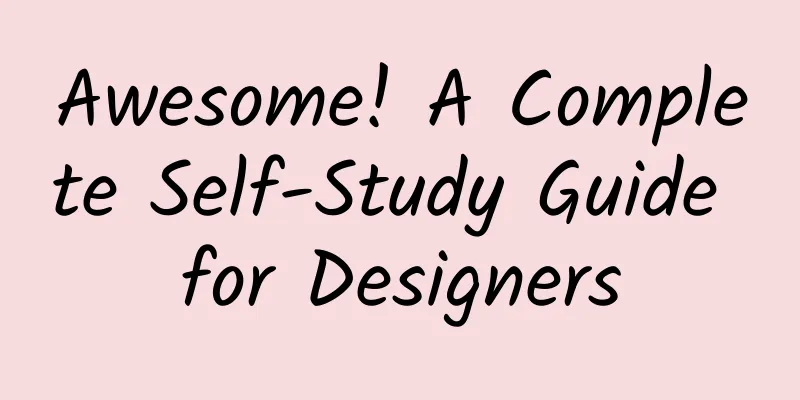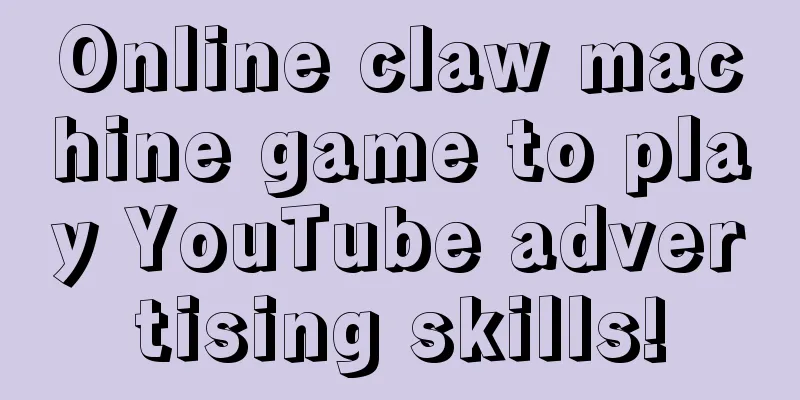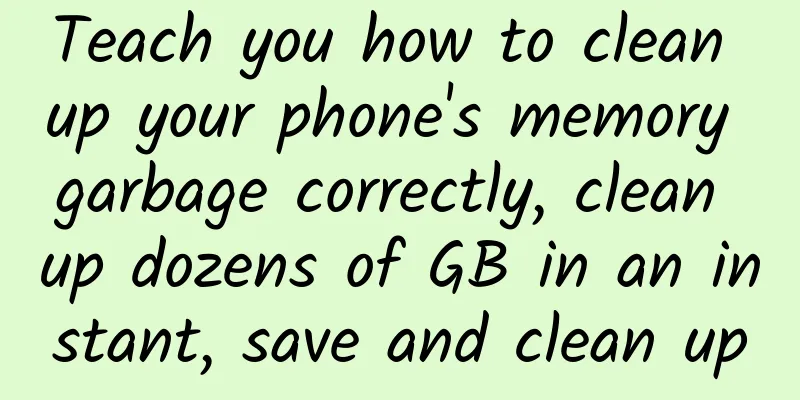Awesome! A Complete Self-Study Guide for Designers

|
This article is translated from Quora, a high-quality foreign Q&A community. The original author, Karen X. Cheng, was originally a Microsoft Excel project manager, and later transformed herself into a designer through self-study. The self-study process she described is detailed, meticulous and well-organized. After reading it, you will find that it is very different from what you imagined. For those who want to learn design by themselves but don't know where to start, you can follow her steps to learn. In addition to proper planning, you can also have a global understanding of design: ) Before reading, let’s take a look at how an 18-year-old genius boy in China taught himself to build his personal website. A Complete Self-Study Guide for Designers: I didn't graduate from a design department, but I got a job as a designer. I wanted to change jobs and become a designer, but I didn't have four years and $100,000 to go back to school, so I decided to teach myself. At first, I was quite skeptical whether a person could find a related job by self-studying. The answer is: Yes I taught myself design for six months while working. Although I didn’t feel ready, I still interviewed with many companies and finally found a job at a great startup Exec. I know I'm not better than many design students who graduate from professional programs, but I'm good enough to do my job well. I design a lot of things, such as websites, iPhone apps, emails, social media, and print. 1. Learn to observe: The most common mistake made by beginners is to jump right into Photoshop. You should be aware that learning Photoshop does not make you a designer, just like buying a set of high-quality brushes does not make you an artist. Start with the real basics. First, learn a little drawing:
Study Graphic Design Theory:
Review these awesome tutorials every day → psd.tutsplus. Of course, you can also follow the design section of Youshe every day Learning the basics of user experience: There are many books on user experience. I recommend starting with these two: The Design of Everyday Things → Chinese version (Design Psychology) PDF, download from WePan, Don't Make Me Think → Chinese version (Don't Make Me Think) PDF, download from WePan Learn how to write: Don't fill up the page with nonsense. As a designer, your job is not just to draw beautiful pictures, you must also be a good communicator. Think about all your past experiences and choose every word carefully. Remember to "speak human language" instead of a bunch of nonsense like in school reports to fill the word count.
Learn to give up your own work: This is the most difficult part. Be prepared to destroy your work at any time, just like killing your own child. The sooner you can prepare yourself, the faster you can get started. So if you feel that the finished product is not good enough, you can always chop it off and start over. Find another pair of impartial eyes: Ask people who understand design for their opinions on your work. If you don’t have such friends around you, go to designer gatherings or related events to meet a few!
Also ask non-designers what they think of your work. Ask your future users to try out your website or app. Don’t be afraid to ask strangers for their opinions. I once had a flight delay, so I used the opportunity to ask other passengers in the terminal what they thought of the app I was designing. They were mostly happy to help, and I got a lot of great feedback. Listen: Really listen to other people's opinions, and don't be defensive. When you ask for someone's opinion and they take the time and effort to answer you, don't respond with defensiveness. Instead, thank them, ask them questions, and then consider whether to adopt their opinion. 2. Learn to use Photoshop and Illustrator Yay! Now that you have a pretty solid foundation in visual design and user experience, you can move on to the next step. In fact, I recommend starting with Illustrator and then moving on to Photoshop. Designers often use Illustrator to create logos or illustrations, while InDesign is great for creating printed materials like flyers or business cards. Learn to use Illustrator: There are countless books and websites that teach you how to use Illustrator. You can pick the ones you like. Here are some of my favorites:
Now comes the fun part, go to the following free learning websites and see how much you have learned! Here are two of my favorites: logo and scenic landscape. Learn to use Photoshop: There are thousands of tutorial sites on the Internet, but many of them are terrible. Fortunately, there are still a lot of high-quality tutorial sites, such as PSDTuts. If you want to learn how to make iPhone apps, there are great tutorials here; if you want to learn how to make web pages, check out this site. Those who are not good at English can directly come to Youshe to learn → PS tutorial If you take an hour or two out of your day to review these lessons, you'll make progress at a rate that will amaze you. 3. Learn professional skills Do you want to design apps, websites, or infographics? I recommend trying them all and then choosing the area that interests you the most. Learn to design a logo:
Learn to design applications:
Learn to design web pages: 1. Read "Don't Make Me Think" to learn how to make a web page that is easy to read. Here comes the question: As a designer, do you have to know HTML or CSS? My answer is that it depends on the nature of the job, but knowing these will definitely be a plus for the job. There are many resources on the Internet for learning HTML and CSS: 4. My favorite free website is Web Design Tuts. 4. Build your portfolio If you want to be a designer, you don't need to go to school, but you definitely need a portfolio. That being said, if you're just starting to learn design and haven't studied related majors, where can you start with a portfolio? Here's the good news: you don't need to actually handle a project to build a portfolio. You can list the following finished products:
Also remember:
5. Find a job as a designer When I first started learning design, I went to a designer workshop that was full of senior designers looking for jobs, several with 5, 10, or even 15 years of experience. The thought of having to compete with them was daunting. Yet a year later, I had successfully found a job as a designer. I think I had one key advantage over other designers: I knew how to work with software developers. Go learn some interactive design, or basic HTML and CSS syntax! Designers in the tech industry (interactive devices, web pages, and app designers, etc.) are in high demand and earn high salaries. If you don’t have experience working with developers, you can participate in Startup Weekends, Hackathons, etc. ***, tell everyone around you that you want to be a designer! Anyone can be the person who helps you find a job. Keep learning even after you find a job I have been working at Exec for a year now and I have learned a lot from this job. I will learn from designers who are more experienced than me, find other design courses, such as TutsPlus and the Udesign Design section, which are good online courses, and even look through design books in bookstores. There are still many things I can learn and improve. Remember to keep honing your skills and keep learning. |
<<: Colorful data! 13 reliable and practical infographic creation tools
Recommend
Solution sharing | Internet home improvement brand planning and marketing promotion suggestions!
Competition is fierce in the new media marketing ...
Interstellar "Spring Cleanup": A Guide to Cleaning Up Space Junk
Three years ago, astronauts on the International ...
Jike App - Competitive Product Analysis Report
One sentence introduction: My version: A minimali...
OS X is not secure? But it is better than Windows.
[[152379]] Apple's OS X desktop operating sys...
[Collection] 45 essential tools for bidding promotion to help you master search marketing!
This time, I have separately counted some essenti...
How to create a video account with 100,000+ likes
How to create a video account with 100,000+ likes...
Sales volume drops, costs rise, and the TV industry is going through its toughest test in a decade
Halfway through 2017, the home appliance industry...
What is flowing out of this tree? Can it also generate electricity for new energy vehicles?
In the 1970s, people discovered a magical tree on...
Successful synthesis! Zhejiang University's latest research on cage-shaped lattice materials is published in Nature
About 40 years ago, unconventional superconductor...
Liu Tong talks about survival in the workplace: 20 heartfelt answers to key questions
Course Catalog: 01 【Editorial】Resolve workplace d...
In the New Year's greetings, those great weapons of the great powers that can "go to the sky, the sea and the land"
President Xi Jinping has delivered New Year's...
Why do we have to develop a hydrogen bomb, he said -
He is the recipient of the "Medal of the Rep...
Tips for building a private domain traffic personal account operation system
Under the influence of the 2020 epidemic, China&#...
How to hide some apps from the iOS home screen
If you are annoyed by the app icons that fill the...
Marketing Promotion Calendar for April 2019 (with Mind Map)
The new media industry and copywriting marketing ...









